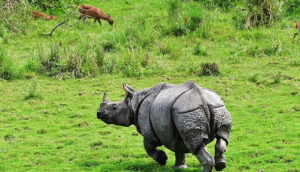Published on: March 30, 2022
RHINO CENSUS IN KAZIRANGA
RHINO CENSUS IN KAZIRANGA
NEWS
The population of the greater one-horned or Indian rhinoceros in the Kaziranga National Park and Tiger Reserve has increased by 200 in four years, the latest census has revealed

DETAILS
- The last rhino census conducted in 2018 had put the number at 2,413
- There are 2,613 rhinos, which indicates an annual increase of 50 rhinos since 2018.
- During this period, Kaziranga lost 400 rhinos due to natural causes while poachers killed three
- This year’s census had a first — the use of drones for the recheck of 26 park compartments where the sample survey was done
INDIAN RHINOCEROS
- Also called the greater one-horned rhinoceros
- Native to the Indian subcontinent
- Vulnerable on the IUCN Red List and Schedule I animal in the Wildlife Protection Act, 1972
- It once ranged across the entire northern part of the Indian Subcontinent, along the Indus, Ganges and Brahmaputra River basins, from Pakistan to the Indian-Myanmar border
- Poaching for rhinoceros horn became the single most important reason for the decline of the Indian rhino
KAZIRANGA NATIONAL PARK
- Located in the state of Assam, India
- UNESCO World Heritage Site
- Hosts two-thirds of the world’s great one-horned rhinoceroses. Rhinos are listed as vulnerable on the IUCN Red list of Threatened Species.
- Home to the highest density of tigers among protected areas in the world, and was declared a Tiger Reserve in 2006
- Home to large breeding populations of elephants, wild water buffalo, and swamp deer
- Recognized as an Important Bird Area by BirdLife International for conservation of avifaunal species
- Combines high species diversity and visibility
- Is a vast expanse of tall elephant grass, marshland, and dense tropical moist broadleaf forests, criss-crossed by four major rivers, including the Brahmaputra, and the park includes numerous small bodies of water
- Celebrated its centennial in 2005 after its establishment in 1905 as a reserve forest

